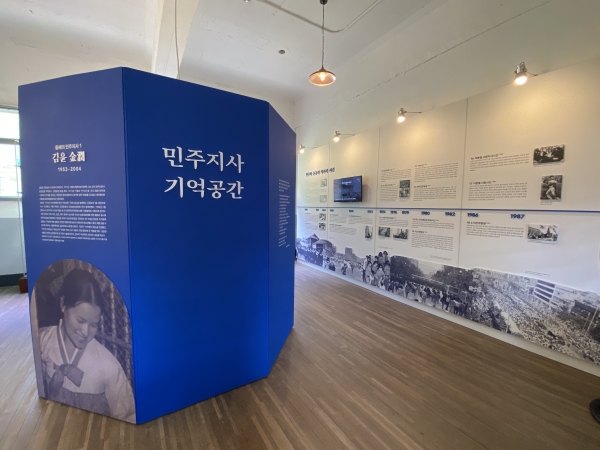
Gwangbokjeol is a meaningful day to remember the liberation of Korea from Japan. To commemorate this day, Seodaemun-gu hosted the Seodaemun Independence/ Democracy festival.
The Seodaemun Independence/ Democracy festival shares the values of independence and democracy every year on National Liberation Day. Owing to COVID-19, the events were held in three different places to disperse visitors: Seodaemun Prison History Museum, Sinchon Cultural Power Station, and Leica Cinema. Online events such as 2021 Online Independence Activist, VR Escape Room: Hurray for Korean Independence, and Online Stamp Tour of Independence/Democracy Road were newly formed due to the pandemic as well.
On Aug. 23, Ewha Voice visited the Seodaemun Prison History Hall. The Cheolhyeol Liberation Corps Exhibition was held at the factory building inside the Prison History Hall built in 1923. It was established to produce textiles, threads, and clothes, which were supplied to prisons, military units, and government agencies across the country.
Cheolhyeol means blood and iron, which is a metaphorical term for weapons and blood during wars. The Cheolhyeol Liberation Corps, an organization of independence fighters against imperial Japan founded by young Korean adults, launched an attack to take hold of cash being transported to Japan. Although patriots were later arrested and executed, the military arms purchased with the fund contributed significantly to the victory of the Cheongsanri Battle. Visitors can honor the historical importance of this operation in that it marked a huge turning point from peaceful resistance to armed struggle against imperial Japan.
The Independence Flag Flying exhibition and Special Exhibition of Portraits of Survived Patriots were opened by its manager - Lee Seung- yun. Lee is currently in charge of relics management, exhibitions, and educational programs in the Seodaemun Prison History.

Both exhibitions were planned to commemorate the 76th anniversary of Korea’s liberation. Lee highlighted that the Special Exhibition on Portraits of Survived Patriots was proposed by the Ministry of Patriots and Veterans Affairs. The fact that only 16 of living independence activists exist today propelled her to open the exhibition this year. Additionally, the difficulty of hosting a face-to- face event due to the pandemic led to the idea of organizing exhibitions.
“We believe that the Seodaemun Prison History Hall plays an important role in promoting the values of freedom and peace while honoring those who have struggled to preserve those values,” Lee stated. “The two exhibitions are both emphasizing that well-known independence activists are less than one percent of all patriots. Without the efforts and sacrifices of numerous unknown activists, we would not be citizens of an independent nation.”
All in all, there were no major difficulties hosting the exhibition during the pandemic. However, in the case of the Special Exhibition on Portraits of Survived Patriots, which paints portraits to pray for the health and longevity of living independence activists, one patriot passed away during preparation. This unexpected event worried Lee throughout the preparation and made her realize the importance and urgency of the exhibition once more.
Artistic efforts were made to honor the independence fighters. The Pansori Les Miserables - Gavroche was presented as part of the Seodaemun Independence/ Democracy festival. The performance was truly original in the sense that it reorganized the character Gavroche in Victor Hugo’s novel “Les Miserables” into a nine- year-old Korean child.
Put out to the streets due to heartless parents, the main character finds a doll in a pile of trash, which is later utilized to store ammunition stolen from the Japanese army. Running into an independence fighter, he enters a whole new phase of his life by becoming an independence activist himself. The story of a nine-year-old boy who became a righteous soldier to create his own path reflects the meaning of the Korean independence movement and National Liberation Day.
“I want people to listen to the stories of each and every independence activist,” Lee remarked. “The reason why history taught at school is not entertaining is because it focuses on large events and organizations. If you happen to know any independence activist, please take a closer look at his or her life. Immersing yourself in their stories will allow you to appreciate their sacrifice. In the end, the commemoration of independence activists is the manifestation of such brave minds.”

